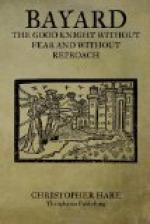The dining-hall was used as a court of justice when the lord of the castle had to settle any difficulties, to receive his dues, or reprimand and punish any refractory vassal. At one end of this hall was a great hearth, where most substantial logs of wood could be laid across the fire-dogs, and burn with a cheerful blaze to light and warm the company in the long, cold winter evenings. At meal-times trestle tables were brought in, and on these the food was served, the long benches being placed on each side of them. On the special occasions of important visits or unusual festivities, a high table was set out at the upper end. The floor was covered with fresh rushes, skins of wolf or bear being laid before the fire, and the walls were stencilled in white and yellow on the higher part, and hung with serge or frieze below. Only in the lady’s chamber do we find carpets and hangings of tapestry or embroidery, part of her wedding dowry or the work of her maidens. Here, too, were a few soft cushions on the floor to sit upon, some carved chairs, tables, and coffers. The master of the house always had his great arm-chair with a head, and curtains to keep off the draughts, which were many and bitterly cold in winter-time.
The chronicler of Bayard, known as the “Loyal Servitor,” begins his story on a spring day of the year 1487.
Aymon Terrail, lord of Bayard, sat by the fireside in his own chamber, the walls of which were hung with old arms and trophies of the chase. He felt ill and out of spirits. He was growing old—he had not long to live: so he assured his good wife.
What was to become of his sons when he was gone? A sudden thought occurred to him. “I will send for them at once, and we will give them a voice in the matter.”
To this the lady of Bayard agreed, for she never crossed her lord’s will, and at least it would distract his gloomy thoughts. It chanced that all the four lads were at home, and ready to obey their father’s command. As they entered the room and came forward, one by one, in front of the great chair by the hearth, somewhat awed by this hasty summons, they were encouraged by a smile from their mother, who sat quietly in the background with her embroidery.
The assembled group made a striking picture. The grand old man, a massive figure seated in his canopied arm-chair, with white hair and flowing beard and piercing black eyes, was closely wrapped in a long dark robe lined with fur, and wore a velvet cap which came down over his shaggy brows. Before him stood his four well-grown, sturdy, ruddy-faced boys, awaiting his pleasure with seemly reverence, for none of them would have dared to be seated unbidden in the presence of their father. Aymon de Bayard turned to his eldest son, a big, strongly-built youth of eighteen, and asked him what career in life he would like to follow. Georges, who knew that he was heir to the domain and that he would probably not have long to wait for his succession, made answer respectfully that he never wished to leave his home, and that he would serve his father faithfully to the end of his days. Possibly this was what the lord of Bayard expected, for he showed no surprise, but simply replied, “Very well, Georges, as you love your home you shall stay here and go a-hunting to fight the bears.”




